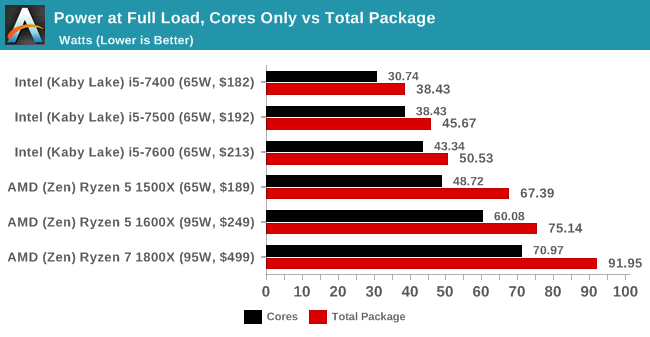- Feb 6, 2011
- 36
- 8
- 81
Is there potential for an "eco-friendly", near-stock-voltage overclock of a Ryzen 1700 that won't cause a loss of single-threaded performance?
I'd like to maintain low idle power usage AND keep load power reasonable. What is "reasonable" to me? Generally no higher than the stock 1800X (about 90W package power -- see graph below). I'll be using a B350 board (Asus) and the stock cooler (Wraith Spire).
What I've heard around the web (which is full of conflicting information):
1) Some folks have reported that idle power usage increases substantially, even with a stock voltage overclock, because the CPU doesn't go into low power states (i.e. it stays in a P0 power state). Others say this is not true: The chip will still downclock and idle at a low power usage, even under a P0 power state. In other words, while "full base clock frequency" is reported, the chip itself will still "downclock" internally and achieve a low idle power usage. Which of these conflicting claims is true?
2) I know you can push clocks considerably higher on this chip (from 3.0 to 3.8-4.0 GHz), but only with considerably higher voltage and power usage at load (i.e. *way* above the 65 watt stock TDP). But is a move from 3.0 to 3.4/3.5 GHz possible/likely at stock voltage on a Ryzen 1700? Or nearly-stock voltage?
3) Related: Some say that modest overclocking is not worth it because you get lower single threaded performance. In other words, you get a slight rise in base frequency (e.g. to 3.4/3.5 GHz), but your chip will no longer boost individual cores to 3.7 GHz and you don't get XFR (another 50 - 100 GHz). Is this true?
4) Finally, if what I'm hoping to do is possible: Is the stock Wraith Spire cooler sufficient for the task of increasing base clocks modestly while maintaining some thermal headroom for Boost/XFR? It is rated for 95W TDP I'm hoping to use no more power than that at load.
THANKS!
==================

I'd like to maintain low idle power usage AND keep load power reasonable. What is "reasonable" to me? Generally no higher than the stock 1800X (about 90W package power -- see graph below). I'll be using a B350 board (Asus) and the stock cooler (Wraith Spire).
What I've heard around the web (which is full of conflicting information):
1) Some folks have reported that idle power usage increases substantially, even with a stock voltage overclock, because the CPU doesn't go into low power states (i.e. it stays in a P0 power state). Others say this is not true: The chip will still downclock and idle at a low power usage, even under a P0 power state. In other words, while "full base clock frequency" is reported, the chip itself will still "downclock" internally and achieve a low idle power usage. Which of these conflicting claims is true?
2) I know you can push clocks considerably higher on this chip (from 3.0 to 3.8-4.0 GHz), but only with considerably higher voltage and power usage at load (i.e. *way* above the 65 watt stock TDP). But is a move from 3.0 to 3.4/3.5 GHz possible/likely at stock voltage on a Ryzen 1700? Or nearly-stock voltage?
3) Related: Some say that modest overclocking is not worth it because you get lower single threaded performance. In other words, you get a slight rise in base frequency (e.g. to 3.4/3.5 GHz), but your chip will no longer boost individual cores to 3.7 GHz and you don't get XFR (another 50 - 100 GHz). Is this true?
4) Finally, if what I'm hoping to do is possible: Is the stock Wraith Spire cooler sufficient for the task of increasing base clocks modestly while maintaining some thermal headroom for Boost/XFR? It is rated for 95W TDP I'm hoping to use no more power than that at load.
THANKS!
==================

Last edited:





